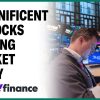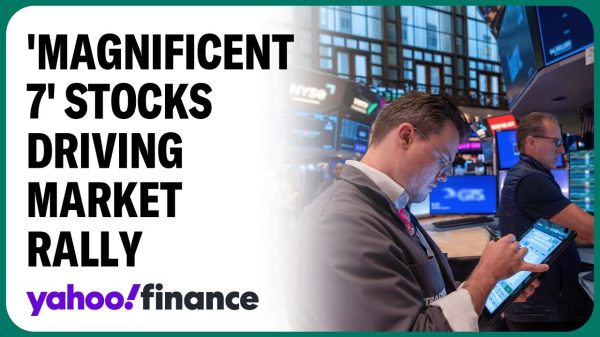Growth funds are hot again. Now some investors are wondering if it’s too late to jump on the bandwagon. Here are some ways to play the trend without getting burned.
The
Nasdaq 100
index, which includes many tech stocks, is up 38.8% through June 30, and some of the largest, most popular tech names, such as
Microsoft
(MSFT), have recently crossed record highs, completely recovering from last year’s downturn. All this is despite the fact that interest rates are now much higher, and valuations should be lower as a result.
Fund performance looks like the mirror image of 2022, when value stocks trounced growth. The average Morningstar large growth fund, which has a 37% tech stock weighting, is already up 24%, while technology funds have gained an average 30%. The $200 billion
Invesco QQQ
exchange-traded fund (QQQ), made up of 51% tech stocks, is up 39%. The more-diversified
S&P 500
index has gained 17%, and large value funds, a measly 5%.
These trends have persisted in the second quarter, with large growth and technology two of the best-performing mutual fund categories, up 11.0% and 9.9%, respectively.
All this raises the question: Have growth-stock funds come too far, too fast?
“We are at an extreme [in growth-stock valuation] that has only been observed a couple of times in history, notably in the aftermath of the 2020 pandemic crash, when everybody treated tech companies as the safe asset, and late 1999,” says Chris Brightman, CEO of Research Affiliates, whose investment strategies are used in managing $120 billion in assets.
As of June 30, the average stock in the MSCI USA Growth Index had a trailing price/earnings ratio of 37.2 versus a 16.7 average for the MSCI USA Value.
Peak Rates
That’s the case against growth stocks. But there’s a case for them. The thing that killed growth stocks last year was rising interest rates. As rates increase, investors expect more profits up front from stocks when comparing them to bonds.
A stock’s earnings yield—comparable to a bond’s yield—is the inverse of its price/earnings ratio. If you can get a 5% yield on a one-year Treasury bill after interest-rate increases, that 30 P/E tech stock with a 3.3% earnings yield looks less attractive than it did when the same Treasuries were yielding almost 0%. Meanwhile, a value stock with a 15 P/E, or a 6.6% earnings yield, still holds some appeal.
Yet once interest rates peak, the equation changes. Wall Street expects rate cuts from the Federal Reserve to stimulate the economy in a much-anticipated recession. If rates go down, that high-P/E stock looks more attractive relative to bonds. Recessions don’t treat weak, debt-laden companies or cyclical ones dependent on economic growth well. Those tend to be value stocks.
“Some of the performance these [growth] companies have seen has been due to an expectation that further interest rate increases may moderate,” says manager Sonu Kalra of the $47 billion
Fidelity Blue Chip Growth
fund (FBGRX), which is up 39% in 2023 after falling 38% in 2022. But Kalra cites additional reasons for the tech sector’s comeback. During the Covid outbreak’s early days, tech companies went on hiring sprees to service a stay-at-home workforce, but they had to adapt last year as their earnings growth slowed with the pandemic’s decline.
“Many of these growth companies began to recognize that we were in a different, slow-growth environment,” he says. “They started adjusting their cost structure. The poster child of that would be
Meta Platforms
(META), formerly known as Facebook, where they instituted a 25% head-count reduction at the end of last year. Fast forward to 2023. The tough decisions that these companies have made have led to improving profitability.” Meta stock is up 145% this year after losing 64% in 2022.
High-Quality Growth
In a slow-growth but high-interest-rate environment, high-quality companies with consistent profits and low debt should prosper. They should also survive if we enter a significant recession—known as a “hard landing”—as some market prognosticators still expect.
But how do you define quality? “We feel like the term ‘quality’ has been commoditized and misappropriated in a way that makes it really hard to be a differentiated large-cap growth quality manager,” says manager Brad Klapmeyer of
Delaware Ivy Large Cap Growth
(WLGAX).
| Fund / Ticker | Morningstar Category | 2nd Quarter Return | YTD Return | 2022 Return | 5-Yr Return | Expense Ratio | Tech Sector % |
|---|---|---|---|---|---|---|---|
| AGGRESSIVE 2023 WINNERS | |||||||
| ARK Innovation / ARKK | Mid-Cap Growth | 9.5% | 41.3% | -67.0% | 0.9% | 0.75% | 33.9% |
| Fidelity Blue Chip Growth / FBGRX | Large Growth | 16.3 | 39.1 | -38.5 | 15.4 | 0.76 | 42.6 |
| Needham Aggressive Growth / NEAGX | Small Growth | 16.8 | 27.3 | -27.5 | 17.0 | 1.88 | 63.6 |
| Spear Alpha / SPRX | Technology | 22.6 | 53.8 | -44.8 | N/A | 0.75 | 88.9 |
| INDEX FUND CHOICES | |||||||
| Invesco QQQ / QQQ | Large Growth | 15.3% | 39.2% | -32.5% | 17.4% | 0.20% | 50.9% |
| iShares Core S&P 500 / IVV | Large Blend | 8.7 | 16.9 | -18.1 | 12.3 | 0.03 | 28.8 |
| iShares Russell 1000 Growth / IWF | Large Growth | 12.8 | 28.9 | -29.3 | 14.9 | 0.18 | 44.0 |
| iShares Russell 1000 Value / IWD | Large Value | 4.0 | 5.0 | -7.7 | 7.9 | 0.18 | 9.3 |
| iShares Russell 2000 Growth / IWO | Small Growth | 7.0 | 13.5 | -26.3 | 4.2 | 0.23 | 23.9 |
| SPDR S&P 400 Mid Cap Growth / MDYG | Mid-Cap Growth | 5.1 | 10.3 | -19.0 | 7.0 | 0.15 | 13.2 |
| SPDR S&P 600 Small Cap Growth / SLYG | Small Growth | 4.8 | 7.0 | -21.2 | 5.1 | 0.15 | 18.8 |
| Technology Select Sector SPDR / XLK | Technology | 15.4 | 40.4 | -27.7 | 21.5 | 0.10 | 99.8 |
| Vanguard Growth / VUG | Large Growth | 13.6 | 33.2 | -33.1 | 14.5 | 0.04 | 45.5 |
| DEFENSIVE 2022 WINNERS | |||||||
| American Century US Quality Growth / QGRO | Large Growth | 7.7% | 20.0% | -24.5% | N/A | 0.29% | 35.9% |
| Delaware Ivy Large Cap Growth / WLGAX | Large Growth | 12.8 | 27.3 | -27.0 | 14.8% | 0.89 | 42.8 |
| Disciplined Growth Investors / DGIFX | Moderately Aggressive Allocation | 15.1 | 25.7 | -18.2 | 9.8 | 0.78 | 40.8 |
| Jensen Quality Growth / JENSX | Large Blend | 5.8 | 10.6 | -16.5 | 12.4 | 0.81 | 29.9 |
| Nicholas / NICSX | Large Growth | 11.2 | 21.6 | -18.1 | 13.8 | 0.71 | 34.0 |
| William Blair Small Cap Growth / WBSNX | Small Growth | 4.3 | 11.2 | -21.6 | 7.1 | 1.24 | 16.4 |
Note: Returns through June 30; five-year returns are annualized. N/A=not applicable
Source: Morningstar
Klapmeyer seeks companies with economic moats around their businesses that should protect them from competitors and ensure durable long-term future earnings growth. Stock price momentum or beating the latest quarterly earnings estimate are less interesting than strong management and competitive advantages.
Some of Klapmeyer’s top holdings are common to large-growth funds, such as Microsoft,
Apple
(AAPL), and
Amazon.com
(AMZN). More interesting is what he leaves out—
Tesla
(TSLA) and Meta—both of which he thinks have competitive challenges. Historically, he points out, the auto industry has been “very competitive.” Tesla’s stock valuation “is already giving [the company] massive credit for the idea that it has a unique distribution network, battery technology, and fully self-driving technology. We don’t have the proof points that any of those should be priced into valuation certainties.” He also doesn’t see any unique differentiation to Meta versus other social-media platforms.
By contrast, Microsoft, 14% of Klapmeyer’s portfolio, is “a market leader across some of the most compelling trends and technologies”—subscription-based software programs like Microsoft 365, cloud computing, and even AI, with its investment in OpenAI, ChatGPT’s creator.
Low or no debt is essential for many quality growth investors. “We always have focused on companies that have good cash flow and lower debt on their balance sheet,” says David Nicholas, a manager of the
Nicholas Fund
(NICSX). “That tends to help going into a recession.”
The Nicholas Fund’s quality focus generally leads it to outperform its growth-fund peers during downturns like we saw last year, and lag during big rallies like the current one.
You’ll find similar downside protection but less speculative upside with
Jensen Quality Growth
(JENSX). It typically invests in only 25 to 30 high-quality blue-chip stocks with reasonable valuations and a minimum 15% annualized return on equity over the past 10 years.
You can also get low-cost exposure to quality growth stocks via “smart beta” index ETFs that employ rules-based quantitative screens.
American Century U.S. Quality Growth
(QGRO) is one which has proven defensive and has a modest 0.29% expense ratio.
All of the above quality-focused funds outperformed their peers in 2022’s downturn.
The Index Question
There are, of course, traditional low-cost growth index funds. The
Vanguard Growth
ETF (VUG) has a 0.04% expense ratio and the
iShares Russell 1000 Growth
(IWF) an 0.18% one. The question is how comfortable you are with having about 25% of your portfolio in just two stocks—Microsoft and Apple—as these ETFs have similar weightings in the current market favorites.
“I think those [concentrated stock] weightings in those [growth] indexes are dangerous,” says Nicholas. “We have been trimming some of our larger-cap names that have had these big runs.”
Most active managers employ some form of valuation discipline that can hold them back in markets like this one. Research Affiliates’ Brightman thinks Nvidia, which recently had a trailing P/E ratio of 222, is like
Cisco Systems
(CSCO) in 1999’s dot-com bubble—a good business with an overvalued stock: “If you bought Cisco near the highs in late 1999, your returns are just about break-even today.”
While Nicholas does own Nvidia, its 1.6% weighting is far less than Invesco QQQ’s 7% and the two growth ETFs’ 5%. Instead, the fund’s management team has been buying lesser-known midsize tech companies, such as digital advertiser
Trade Desk
(TTD) and cybersecurity company
CrowdStrike Holdings
(CRWD).
Small-Caps
There are virtues now to investing in smaller companies, with more room to grow than what Wall Street has recently dubbed the “magnificent seven” driving the market—Apple, Microsoft, Nvidia,
Alphabet
(GOOGL), Amazon, Meta, and Tesla.
One of the best growth funds for risk-conscious investors worried about the next downturn is
Disciplined Growth Investors
(DGIFX). One reason is it holds some bonds, typically 35% of its portfolio, as ballast to its more-volatile stocks. Its managers also pay attention to valuations and focus on mid- and small-cap stocks. This balanced approach has enabled the fund to beat 97% of its peers in Morningstar’s Moderately Aggressive Allocation category in the past decade.
With stocks, Disciplined Growth’s managers seeks a 12% annualized return. Typically, 9% or 10% of that performance comes from a company’s earnings growth, and another 2% to 3% from purchasing its shares cheaply.
That growth and valuation discipline generally keeps the fund out of pricier and slower-growing large-caps. About the only celebrity AI stock in Disciplined Growth’s portfolio is
Super Micro Computer
(SMCI), which is up 554% in the past year. But the fund’s history with that stock reveals how differently its managers think from their peers. “We’ve owned it for 12 years,” says lead manager Fred Martin. “We made dog squat on it for the first 10, and now it’s paying off.”
More typical are lesser-known companies like laser-welding equipment maker
IPG Photonics
(IPGP). “IPG has introduced a hand-held laser welder, which is really disrupting the market,” says Jason Lima, a fund co-manager. “There’s a real lack of professional welders.” The new laser welder enables people to do professional-grade welding work with “very little training.”
Avoiding Junk
Unfortunately, there are many poor-quality small-cap growth companies, making index funds less suitable for getting exposure. “There’s a fairly large percentage of companies in our benchmark [the Russell 2000 Growth], about 32%, that are technically unprofitable,” says Mark Thompson, manager of the top-performing
William Blair Small Cap Growth
fund (WBSNX). Some of those are what Thompson calls “zombie companies,” which, to survive, are “going to have to raise more capital. That isn’t good in a higher-rate environment.” Meanwhile, others will thrive eventually.
If you want a low-cost index fund, consider the
SPDR S&P 600 Small Cap Growth
ETF (SLYG) or the
SPDR S&P 400 Mid Cap Growth
ETF (MDYG), as their more selective S&P benchmarks require companies to be profitable to be included in them. But the best active small- and mid-cap funds often beat these benchmarks by a wide margin.
Needham Aggressive Growth
(NEAGX) is one such fund. Manager John Barr likes to think about the long-term growth prospect for small, young tech companies—recently 64% of his portfolio. Despite this large tech weighting, Barr’s fund has proven defensive, with less downside in falling markets and more upside in rising ones than its peers in Morningstar’s Small-Growth category over the past decade.
While Barr has held popular AI-driven names like Super Micro Computer and
PDF Solutions
(PDFS) for many years, he also invests in overlooked tech, such as software company
Unisys
(UIS), down 21% this year. “The market is missing the value of Unisys’ ClearPath Forward legacy operating system,” he says. Being valuation-conscious has served Barr well in past downturns.
Soft Landing
There’s a case for considering more-aggressive funds. If the government manages to engineer a soft landing—that is, a mild or better yet nonexistent recession—defensive large-cap funds like Jensen Quality Growth and the Nicholas Fund will continue to lag behind their more-aggressive peers. But investors are understandably gun-shy after last year’s debacle.
For instance,
Spear Alpha
(SPRX) is an aggressive pure tech ETF that is the best-performing actively managed stock ETF this year, up 54%. Yet, having launched in August 2021, right before the crash, the fund only has $9 million in assets.
Meanwhile, the
ARK Innovation
ETF (ARKK), which launched in 2014, invests in similarly high-octane stocks, and it has $8 billion. Yet, Spear Alpha has beaten ARK Innovation both last year—when ARK fell 67% and Spear 45%—and this year, as ARK is up 41%. Spear has also beaten ARK’s smaller $1.4 billion pure tech ETF,
ARK Next Generation Internet
(ARKW).
Spear manager Ivana Delevska has impeccable credentials, having worked previously as a senior analyst for illustrious hedge fund firms such as Citadel Asset Management and Millennium Management. She has proven particularly adept at navigating the ups and downs of the most volatile tech stocks. Unlike more conservative managers, she’s willing to trade aggressively. Her fund’s turnover ratio is 262%, indicating a holding period of only a few months. Mostly she trades around her favorite stocks, selling them if they get overpriced, then buying them back when they decline.
She has employed such tactical trading with Nvidia since the fund’s launch. (ARK Innovation sold its Nvidia position earlier this year, to its detriment.) More recently, as a “value idea,” she has been buying the former Covid market darling
Zoom Video Communications
(ZM), which has fallen 37% in the past year as the pandemic threat ebbed.
The problem today is that investors are faced with a more difficult choice after 2022’s bloodbath, when even the more-diversified iShares Russell 1000 Growth fell 29%.
Delevska is actually glad Spear Alpha launched right before last year’s crash. “I think it’s better for people to see how your product does through a down cycle,” she says.
Perhaps if we have a soft landing, her ETF may one day have billions instead of millions.
Email: [email protected]
Read the full article here











